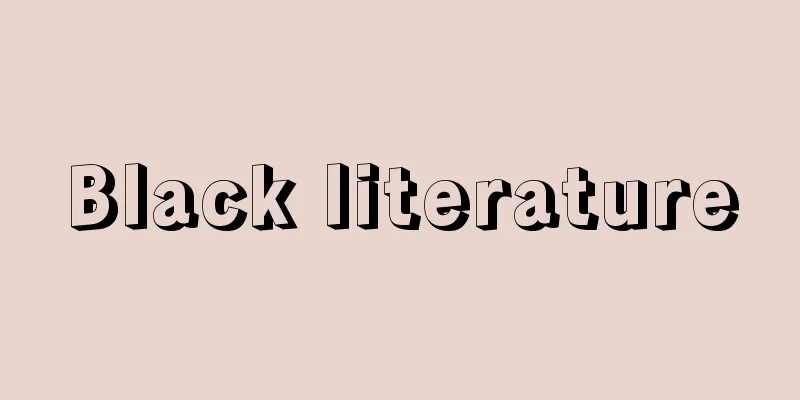Black literature

|
Literature by black people. It is broadly divided into African black literature, Caribbean black literature, and American black literature. In Japan, it generally refers to American black (African American) literature. In the early period of American history, the words "black people" were "African," "Colored," "Freedman," "Negro," and "Black," but the most widely and long-used word was "Negro." However, from the mid-1960s, this was criticized as a term symbolizing slavery, and the use of "Black" was advocated. Furthermore, since the 1970s, African studies and African American studies that explore the group identity of black people have become popular, and as black people re-recognize their own history and traditions that originated in Africa, "Afro-American" and "African American" have come to be widely used, as they proudly convey their connection to Africa. The term used to mean "black literature" also reflects this change; until around the 1960s, "Negro literature" was used, then "Black American literature" was used until the early 1980s, and from the late 1970s onwards, "Afro-American literature" and "African American literature" were commonly used, and now "African American literature" is the more common term, which indicates a stronger cultural unity and identity. American black literature was destined to be a literature alienated from American culture from the beginning, due to the historical fact that black people were imported to the New World, bought and sold, and forced to work as slaves from 1619 onwards. Since the real society in which black people lived was a kind of closed concentration camp society, the slave system, it goes without saying that their literature aims to restore the humanity that was lost in the long course of history. The first published work by an American black person was a collection of poems (1773) by Phillis Wheatley (1753?-1784), but this was an exception, and the first literary expression by ordinary black people who survived the extreme conditions of slavery was the "slave's memoir." It began to appear in the late 18th century and reached its peak in the middle of the 19th century, producing excellent "memoirs" by F. Douglas and Harriet Jacobs (1813-1897). This tradition continues today in the autobiographies of Malcolm X and Maya Angelou (1928-2014). [Aiko Sagawa November 19, 2018] Southern Literature to the Early 20th CenturyEven after the Civil War ended and the Emancipation Proclamation was issued, the oppression and exploitation of black people in the South continued in different forms. The Jim Crow system, a strict racial segregation policy, took hold, and lynching laws, vigilante executions, and the deprivation of educational opportunities became more severe. Black writers from the late 19th century to the early 20th century took up the theme of racial discrimination with the aim of social reform. These include William Wells Brown's (1814?-1884) Clotel, the President's Daughter (1853), Frances Ellen Watkins Harper's (1825-1911) Iola Leroy (1892), Charles W. Chesnutt's (1858-1932) Essence of Tradition (1901), and James Weldon Johnson's (1871-1938) Autobiography of an Ex-Slave (1912). What is noteworthy here is that the protagonists of these works, most of which were written for white readers, are white-skinned mixed-race blacks. The theme of "passing," which deals with the tragedy of white-skinned mixed-race blacks who look the same as white people, has been repeated as a distinctive feature of black literature since then as a uniquely black experience. [Aiko Sagawa November 19, 2018] 1920s–1950s: Northern and urban literatureIn the late 19th and early 20th centuries, Jim Crow, lynchings, low wages, and increasing riots in the South led to a large migration of blacks to northern cities, where they gained new cultural and political energy. The 1920s in particular saw the emergence of an awakened "new black" that produced many intellectual and artistic works, known as the Harlem Renaissance. These included Langston Hughes, Zola Neale Hurston (1891-1960), Nella Larsen (1891-1964), Jean Toomer, Arna Bontemps (1902-1973), Countee Cullen (1903-1946), and Claude McKay (1889-1948). However, the long economic depression that began with the Great Depression of 1929 and continued through the 1930s and 1940s caused black people to feel increasingly victimized, as they continued to live miserable lives due to unabated discrimination, and their literature also began to clearly feature the theme of "protest." Representative works of "protest literature" from this era include Bontemps' Black Lightning (1936), Richard Wright's American Son (1940), and Ann Petry's (1908-1997) Streets (1946). Wright's American Son is said to be the first novel by a black writer to stand shoulder to shoulder with white literary works, and is a monumental work that represents the era. This masterpiece, which created the character "Bigger" as a typical black person, ironically established the formula "black literature = protest literature" and "black people = Bigger Thomas." Black literature from the 1950s onwards would develop by challenging and overcoming this formula. [Aiko Sagawa November 19, 2018] 1960s – Black Arts MovementFor Ralph Ellison, Wright's Bigger was constructed not as a human being, but as an indictment of white oppression. He consistently avoided narrow ideological subject matter, and wrote Invisible Man (1952), which illuminated the complexities and contradictions of the modern human condition more generally. James Baldwin began his career as a writer by publicly criticizing American Son. However, the aesthetically-oriented and apolitical artistic stance of his debut novel, Go Up to the Mountain and Tell It (1953), gave way by the mid-1960s to works that were prophetic and political in their interpretation of what it meant to be black in America. Despite the rise of the civil rights movement in the late 1950s and 1960s, the lives of black people did not improve at all. As discontent grew, riots broke out all over the country in the 1960s, black movements strengthened their black nationalist tendencies, and the cry of "Black Power" began. In conjunction with this, the "Black Arts Movement" arose in the arts, linking art with the political movement for black liberation. Poet, playwright, and music critic Amiri Baraka (Leroy Jones), poet Nikki Giovanni (1943-), Sonia Sanchez (1934-), and critic Addison Gayle Jr. (1932-1991), who wrote "The Black Aesthetic" (1971), were among the active figures. [Aiko Sagawa November 19, 2018] The 1970s and After: The Emergence of Female WritersThe civil rights movement and the black nationalist movement turned black people's interest to the source of their ethnic culture. In the 1960s, African countries broke the yoke of Western colonial rule and achieved political independence one after another, which also stimulated black literature from the 1970s onwards, with pride in their ethnicity, and a stronger tendency to seek new values and an identity as black people and as humans. In addition, the wave of radical feminism (women's liberation) that emerged from the counterculture movement at the end of the 1960s steadily swept through black society, giving birth to black feminism, or what Alice Walker calls womanism, which was distinct from white middle-class feminism, and ushered in a heyday of black female writers, as if the talents of black women writers that had been suppressed until then had suddenly blossomed. Notable writers include Paule Marshall (1929-2019), Maya Angelou, Ntozake Shange (1948-2018), Gayl Jones (1949- ), June Jordan (1936-2002), Audre Lorde (1934-1992), Toni Morrison, and Alice Walker (Toni Morrison passed away in 2019). Among them, Toni Morrison and Alice Walker are major authors who have had a great influence on the contemporary American literary world. Toni Morrison, winner of the Pulitzer Prize for Beloved in 1987 and the Nobel Prize for Literature in 1993, challenges the destructive power of central ideas in Western civilization and celebrates the capacity for resistance, creativity, and self-realization that is so carefully preserved in African-American culture and ritual. Alice Walker, winner of the Pulitzer Prize for The Color Purple in 1982, has also been central in unearthing and preserving African-American folk traditions. Walker challenges readers to consider the tensions between theory and practice, gender and race, and to confront the contradictions inherent in their own existence as social subjects. [Aiko Sagawa August 20, 2019] The Challenges of Black LiteratureIn the current age of globalization in all aspects of human life, the subject matter and style of black literature are more diverse than ever before. Many writers seem to be interested in the meaning of the African diaspora and Pan-Africanism, the reconsideration and re-empowerment of black people and history, the construction of meaningful sexual differences, and so on. All of these issues have their roots in early black American history and literary expression, and are interconnected with the cultural and literary traditions of other ethnic groups. As globalization continues to advance, and the readership expands, black literature will continue to explore even more diverse possibilities. However, the current situation of black people in America is far from bright. The results of "affirmative action" to rectify discrimination from the 1970s to the end of the 1990s have been steadily improving in the form of advances for black people in various fields, but the situation of lower-class black people who have not benefited from these advances remains serious. How can black literature relate to these issues that current American black society faces, along with global themes? This is perhaps the challenge for American black literature in the future. [Aiko Sagawa November 19, 2018] "Complete Works of Black Literature," 12 volumes, 1 supplementary volume (1951, Hayakawa Publishing)" ▽ "The World of Black Literature, by Hashimoto Fukuo (1967, Miraisha)" ▽ "American Black Novels, by Robert A. Vaughn, translated by Saito Kazue (1972, Kitazawa Tosho Publishing)" ▽ "American Black Liberation and Literature, by Ikegami Hideo, Ito Kenji, Suda Minoru, and Tanaka Rei (1979, Shin Nihon Shuppansha)" ▽ "Collected Works of Hashimoto Fukuo 2: Black Literature Theory," by Hashimoto Fukuo (1989, Hayakawa Publishing)" ▽ "Bibliography of Black Literature, edited by Kiuchi Toru (1994, Takashobo Yumi Press)" ▽ "Encyclopedia of Black Authors, edited by Kiuchi Toru (1996, Takashobo Yumi Press)" ▽ "American Black Literature and Its Surroundings," edited by the Editorial Committee for the Collection of Essays Commemorating the Retirement of Professor Sekiguchi Isao (1997, Nagundo Phoenix)" ▽ "Black Literature and the Invisible City: America/Sweet Home" by Charles Scruggs, translated by Matsumoto Noboru et al. (1997, Sairyusha) " "Black Literature of the World: Africa, the Caribbean, and America" edited by Kato Tsunehiko, Kitajima Yoshinobu, and Yamamoto Shin (2000, Takashobo Yumi Press)" " Black Boy: A Childhood Chronicle, Volumes 1 and 2, by Richard Wright, translated by Nozaki Takashi (Iwanami Bunko)" [References] | | | | | | | | | | | | | | | | | | | | |Source: Shogakukan Encyclopedia Nipponica About Encyclopedia Nipponica Information | Legend |
|
黒人による文学。アフリカ黒人文学、カリブ黒人文学、アメリカ黒人文学に大別される。日本ではだいたいアメリカ黒人(アフリカ系アメリカ人)文学をさしてきた。「黒人」をさすことばは、アメリカ史の初期には、“African”、“Colored”、“Freedman”、“Negro”、“Black”などが使われていたが、もっとも広く、長く使われたのは“Negro”であった。しかし、1960年代中ごろから、これは奴隷状態を象徴する呼称として批判され、“Black”を使うことが提唱された。さらに1970年代以降は、黒人としてのグループ・アイデンティティを模索するアフリカ研究やアフリカン・アメリカン研究が盛んになり、黒人たちがアフリカに起源をもつ自らの歴史・伝統を再認識するなかで、アフリカとのつながりを誇りをもって伝えるという姿勢から、“Afro-American”や“African American”が広く使われてきている。「黒人文学」を意味することばも、この変化を反映して、1960年代ぐらいまでは“Negro literature”、それ以後1980年代の初めぐらいまでは“Black American literature”、1970年代後半以降は“Afro-American literature”や“African American literature”が多く使われ、現在は、文化的統一性とアイデンティティをより強く示す“African American literature”が一般的である。 アメリカの黒人文学は、1619年以降、黒人がこの新大陸に輸入され、売買され、奴隷として働かされた歴史的事実によって、最初からアメリカ文化から疎外された文学という宿命を負わされていた。黒人の生きた現実の社会は、奴隷制度という閉鎖的な一種の強制収容所の社会であったから、その文学が、長い歴史の過程で失われた人間性の復権を目ざしていることはいうまでもない。アメリカ黒人の作品が最初に出版されたのは、フィリス・ホイートリPhillis Wheatley(1753?―1784)の詩集(1773)であったが、これは例外であり、奴隷制度の極限状況を生き抜いた一般の黒人の最初の文学的表現は、「奴隷体験記」である。18世紀後半からみられ、19世紀の中ごろには最盛期に達し、F・ダグラスやハリエット・ジェイコブズHarriet Jacobs(1813―1897)のすぐれた「体験記」を生んだ。この伝統は現代もなおマルコム・エックスやマヤ・アンジェロウMaya Angelou(1928―2014)の自伝に引き継がれている。 [佐川愛子 2018年11月19日] 20世紀初頭まで――南部の文学南北戦争が終結し奴隷解放宣言が出されても、南部における黒人の抑圧と搾取は形を変えて続けられた。「ジム・クロウ制度」という徹底した人種隔離政策が定着し、リンチ法、自警団による処刑、教育機会の剥奪(はくだつ)は激しさを増した。19世紀後半から20世紀初頭の黒人作家たちは、社会改革を目ざして、こうした人種差別の主題を取り上げた。ウィリアム・ウェルズ・ブラウンWilliam Wells Brown(1814?―1884)の『大統領の娘クローテル』(1853)、フランシス・E・W・ハーパーFrances Ellen Watkins Harper(1825―1911)の『アイオラ・リロイ』(1892)、チャールズ・W・チェスナットCharles W. Chesnutt(1858―1932)の『伝統の神髄』(1901)、ジェームズ・ウェルダン・ジョンソンJames Weldon Johnson(1871―1938)の『元奴隷の自伝』(1912)などがある。ここで注目すべきことは、大半が白人の読者層に向けて書かれたこれらの作品の主人公たちは、白い肌をした混血の黒人であることである。外見は白人と変わらない、皮膚の色の白い混血黒人の悲劇を扱った、「パッシング」passingという主題は、黒人固有の経験として以後黒人文学の一つの著しい特徴となって繰り返された。 [佐川愛子 2018年11月19日] 1920年代~1950年代――北部・都市の文学19世紀の終わりから20世紀の初頭にかけて、南部でのジム・クロウ、リンチ、低賃金、そして増え続ける暴動のため、黒人は大挙して北部の都市へ移動し、それらの都市は新しい文化的・政治的エネルギーを得て活気づいた。とくに1920年代は、覚醒(かくせい)した「新しい黒人」による知的・芸術的作品が多く生み出された時期で、ハーレム・ルネサンスとよばれる。ラングストン・ヒューズ、ゾラ・ニール・ハーストンZola Neale Hurston(1891―1960)、ネラ・ラーセンNella Larsen(1891―1964)、ジーン・トゥーマー、アーナ・ボンタンArna Bontemps(1902―1973)、カウンティ・カレンCountee Cullen(1903―1946)、クロード・マッケイClaude McKay(1889―1948)らが輩出した。しかし、1929年の大恐慌から始まった1930年代、1940年代の長い経済不況で、依然として衰えない差別待遇によって惨めな生活を強いられ続けた黒人の被害者意識はますます先鋭化していき、彼らの文学も「抗議」のテーマを明確にしていった。この時代の「抗議文学」の代表的なものは、ボンタンの『黒い雷』(1936)、リチャード・ライトの『アメリカの息子』(1940)、アン・ピトリAnn Petry(1908―1997)の『街路』(1946)などである。なかでもライトの『アメリカの息子』は、初めて黒人の小説が白人の文学作品と肩を並べたといわれるものであり、この時代を代表する記念碑的作品であった。作中人物の「ビガー」を黒人の典型として創造したこの傑作は、しかし、皮肉にも「黒人文学=抗議文学」、「黒人=ビガー・トマス」という図式を確定してしまい、1950年代以降の黒人文学は、これに異議を唱え、乗り越える形で発展していくことになった。 [佐川愛子 2018年11月19日] 1960年代――黒人芸術運動ラルフ・エリソンにとってライトのビガーは、人間ではなく、白人による抑圧への告発として、つくりあげられたものだった。彼は一貫して偏狭なイデオロギー的題材を避け、より一般的な現代の人間状況の複雑さと矛盾を照らしだす作品『見えない人間』(1952)を書いた。ジェームズ・ボールドウィンは、『アメリカの息子』を公に批判することで作家としてのスタートを切った。しかし、処女作『山に登りて告げよ』(1953)の審美性を重視し、政治からは一定の距離を置いたような芸術的姿勢は、1960年代中ごろまでには、アメリカで黒人であることの意味を、予言的・政治的にとらえる作品に変わっていった。 1950年代後半から1960年代の公民権運動の盛り上がりにもかかわらず、黒人の生活はいっこうに改善せず、不満が増すなかで、1960年代は全国各地で暴動が頻発し、黒人の運動は黒人民族主義的傾向を強め、「ブラック・パワー」が叫ばれるようになった。これに連動して芸術の分野では、芸術を黒人解放のための政治的運動と結び付ける「黒人芸術運動」が起こった。詩人・戯曲家・音楽評論家アミリ・バラカ(リロイ・ジョーンズ)、詩人ニッキ・ジョバンニNikki Giovanni(1943― )、ソニア・サンチェスSonia Sanchez(1934― )、『黒人の美学』(1971)を著した批評家アディスン・ゲイル・ジュニアAddison Gayle Jr.(1932―1991)などが活躍した。 [佐川愛子 2018年11月19日] 1970年代以降――女性作家の登場公民権運動と黒人民族主義運動は、黒人たちの関心を民族の文化の源へ向けた。1960年代にはアフリカ諸国が、西欧の植民地支配の軛(くびき)を断ち切り、次々と政治的独立を達成していたことも刺激となり、1970年代以降の黒人文学は、民族に対する誇りをもって、それまでにはなかった新しい価値観と黒人として、人間としてのアイデンティティを模索する傾向を強めた。加えて、1960年代末の対抗文化運動のなかから生まれたラディカル・フェミニズム(ウーマン・リブ)の波は黒人社会にも確実に押し寄せ、白人中産階級のフェミニズムとは一線を画したブラック・フェミニズム、あるいはアリス・ウォーカーのいうウーマニズムを生み、それまで押さえられていた黒人女性作家たちの才能が一気に開花したかのような、黒人女性作家隆盛期を迎えた。ポール・マーシャルPaule Marshall(1929―2019)、マヤ・アンジェロウ、ヌトザケ・シャンゲNtozake Shange(1948―2018)、ゲイル・ジョーンズGayl Jones(1949― )、ジューン・ジョーダンJune Jordan(1936―2002)、オードリ・ロードAudre Lorde(1934―1992)、トニ・モリスン、アリス・ウォーカーらの活躍が目覚ましい(トニ・モリスンは2019年没)。なかでも、トニ・モリスンとアリス・ウォーカーは、現代アメリカ文壇で大きな影響力をもつ主要作家である。1987年の『ビラブド(愛されし者)』でピュリッツアー賞を受賞し、1993年にはノーベル文学賞に輝いたトニ・モリスンは、西洋文明の中心思想のもつ破壊的力に挑み、アフリカ系アメリカ人の文化・儀式のなかにたいせつに保存されてきた、抵抗と創造と自己認識を達成する能力を礼賛。1982年の『カラー・パープル』でピュリッツアー賞を受賞したアリス・ウォーカーもまた、アフリカ系アメリカ人民衆の伝統の発掘と維持という点で中心的存在である。ウォーカーは、読者が、理論と実践、ジェンダー(性)と人種の間の確執について考え、社会的主体としての自らの生きざまのなかに内在する矛盾に立ち向かうよう駆り立てる。 [佐川愛子 2019年8月20日] 黒人文学の課題人間生活のあらゆる場面でグローバル化が進んでいる現在、黒人文学の題材と文体は、かつてない多様性をみせている。多くの作家は、アフリカン・ディアスポラと汎アフリカ主義のもつ意味、黒人民衆と黒人の歴史の再認識と復権、性の意味ある差異の構築、等に関心を抱いているようである。これらすべての問題の根は、初期のアメリカ黒人の歴史と文学表現のなかにあり、かつ、他民族の文化的・文学的伝統と相互に関連している。今後ますます進むグローバル化に伴って読者層も広がるなかで、黒人文学は、さらに多様な可能性を模索していくことであろう。 しかし、アメリカの黒人の現状は、けっして明るくはない。1970年代から1990年代末にかけての差別是正のための「アファーマティブ・アクション」の成果は、各方面での黒人の躍進という形で、着実に上がっている反面、その恩恵に浴していない下層階級の黒人たちの置かれた状況は、深刻である。グローバルな題材とともに、現在のアメリカ黒人社会が抱えるこうした問題に、黒人文学がどのようにかかわってゆくのか、ゆけるのか。それが、アメリカ黒人文学の今後の課題であるといえるだろう。 [佐川愛子 2018年11月19日] 『『黒人文学全集』12巻・別巻1(1951・早川書房)』▽『橋本福夫著『黒人文学の世界』(1967・未来社)』▽『ロバート・A・ボーン著、斎藤数衛訳『アメリカの黒人小説』(1972・北沢図書出版)』▽『池上日出夫・伊藤堅二・須田稔・田中礼著『アメリカ黒人の解放と文学』(1979・新日本出版社)』▽『橋本福夫著『橋本福夫著作集2 黒人文学論』(1989・早川書房)』▽『木内徹編『黒人文学書誌』(1994・鷹書房弓プレス)』▽『木内徹編『黒人作家事典』(1996・鷹書房弓プレス)』▽『関口功教授退任記念論文集編集委員会編『アメリカ黒人文学とその周辺』(1997・南雲堂フェニックス)』▽『チャールズ・スクラッグズ著、松本昇他訳『黒人文学と見えない都市――アメリカ/スイートホーム』(1997・彩流社)』▽『加藤恒彦・北島義信・山本伸編著『世界の黒人文学――アフリカ・カリブ・アメリカ』(2000・鷹書房弓プレス)』▽『リチャード・ライト著、野崎孝訳『ブラック・ボーイ――ある幼少期の記録』上下(岩波文庫)』 [参照項目] | | | | | | | | | | | | | | | | | | | | | |出典 小学館 日本大百科全書(ニッポニカ)日本大百科全書(ニッポニカ)について 情報 | 凡例 |
>>: 唃厮囉-Kokushira (English spelling) rGyal‐sra
Recommend
Shrine visit - Miya-mai-ri
The first visit to the ujigami after birth to bec...
Kaigen Gagaku
… In 626 (the 9th year of Wude), the first empero...
Association for the Protection of Working People's Livelihoods
...After World War II, in October 1945, the movem...
Gama (English spelling) vug, vugg, vugh, voog, vough
A cavity within a vein that is not completely fill...
Kyoka Daitai - Kyoka Daitai
…On the other hand, during the An'ei period (...
Family Court - katei saibansho
A lower court that mainly handles adjudication an...
Weaving Princess - Orihime
...As one of the five seasonal festivals, this da...
Saintpaulia - Saintpaulia
A general term for the genus Saintpaulia in the G...
Astana
The capital of Kazakhstan. It means "capital&...
"Anjin Dialogue"
…The author learned navigation by riding on board...
Oose - Oose
A general term for a family or genus of the order...
Greater Bearded Bat - Greater Bearded Bat
...There are 12 species in Japan, accounting for ...
anviksiki (English spelling)
...Indian thinkers called speculation and insight...
Machinery Credit Insurance Law
...In order to contribute to the modernization of...
åkermanite (English spelling)
A type of melilite with the chemical composition C...









